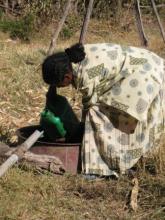Self-supply
Presentation by Henk Holtslag on self-supply which he considers more cost-effective than communal water supply.
Presentation by John Butterworth on recent progress and developments around self-supply in Ethiopia.
Family wells are privately-owned, although generally shared freely with neighbours for domestic use. Traditional hand-dug wells come in a variety of shapes and sizes according to local geology, material availability and know-how. They can be upgraded by stepwise improvements in lining, well head protection and lifting devices.
In the case study Self-supply family wells for Multiple Use water Services the author concludes that with the right support, many existing family wells could be upgraded to provide supplies that are better for productive and domestic uses (especially more quantity) and drinking (better quality). This support should keep ownership at the household and improve the convenience, safety (both in terms of water quality and collapsing) and potential benefits of the well. Increased availability of water thus enhances the potential for multiple uses. This potential is high, as the more water systems are owned on private basis, the greater the opportunity to use them for multiple purposes.
The case study is part of the MUStRAIN case study series in which the uptake of Multiple Use Services (MUS) in different contexts within Ethiopia is being documented. The case studies analyse cost-benefit relations as well as opportunities and challenges for implementation of MUS.
There is reasonably wide recognition of the potential merits of multiple use water services (MUS) in Ethiopia as a result of innovation by NGOs and advocacy by research institutes. The acronym ‘MUS’ is itself increasingly a part of the sector discourse and interest in MUS is on the rise given the growing awareness that food insecurity and water insecurity are related. However, MUS interventions and modalities have generally not been scaled up widely in the country. This seems largely due to the same barriers that MUS faces elsewhere: the conventional institutional structuring of water policies, water services implementation programs, and professional disciplines into fragmented, parallel operating ‘vertical’ sectors of single water uses such as rural water supply and agriculture. Three best-bet opportunity areas are identifed for taking MUS forward. In addition, there is an opportunity for a learning network on MUS focusing on policy and practice in Ethiopia to learn from and leverage the activities of various partners.
This scoping study offers implementable recommendations for investment opportunities in multiple use water services in Ghana. The report is based on an assessment of existing MUS modalities and innovations, potential for implementation and possible barriers. The study shows that MUS is a de facto practice both in formal domestic and irrigation service delivery, complemented by self-supply initiatives. Moving from de facto multiple use practices to a more planned and structured MUS approach can be done from various entry-points. Based on risk assessments, this study concludes that domestic-plus, rehabilitation of small reservoirs and self-supply for irrigation present the best direct investment opportunities for maximum impact.
A presentation given by Barbara van Koppen (IWMI) and Stef Smits (IRC) on MUS-scoping studies on potentials, barriers and scaling pathways in India, Nepal, Ethiopia, Ghana, Tanzania on the 2012 MUS-group meeting in Washington, DC.
A presentation by Stef Smits on basic MUS issues given at the 2012 MUS-group meeting in Washington, DC.
This paper explores the links between multiple use services and self supply approaches, exploring selected cases in Nicaragua and Zimbabwe. The first case illustrates the influence multiple uses have had on the wide uptake and sustainability of rope pumps in Nicaragua. The main reason cited for these is linked to the economic opportunities that have arisen from the development of irrigation and the availability of water for livestock. The second presents the case of family wells in Zimbabwe, where household owned wells are commonly used to serve multiple purposes. The paper finally explores opportunities and challenges of MUS through self supply, such as water quality issues, reaching the poorest and its scalability.
Paper presented by Sally Suttonat the 5th RWSN Forum, Accra, Ghana, 2006.
Self supply is a rural water strategy rather than just low cost technologies. It builds on the largely unrecognised but great investment rural people have already made in their own water supplies, especially at household level. Particularly in areas where comunal approaches are of quetionable sustainability, people can be encouraged to improve their own supplies rathet than remaining dependent on the timing and policies of donors and governments. [authors abstract]
A powerpoint presented by Sally Sutton, Rural Water Supply Network (RWSN). There is a growing awareness of the investment people have made and could make in their own water supply in rural areas. This could be built upon especially if productive use brings a return on investment. The Self Supply approach largely removes the dilemmas of co-ordinating joint sector investments from agriculture and domestic water supply for multiple uses (see MUS Laos discussion), concentrating less on funded implementation and more on creating an enabling environment for people to develop their own solutions. As it is less a top-down donor approach and more a marketing of products and skills, there is a need to think of water supply less in terms of a necessary service and more as user defined solutions which should employ marketing principles for their growth. This in turn highlights some of the areas in which conventional rural water supply is weakest in its understanding of consumer attitudes and practices, which particularly affects sustainability. Marketing approaches to encourage and enable private investment among people who are poor (but generally find a way to attain goals if they really want to achieve them) form an area of common interest to MUS and Self Supply.

